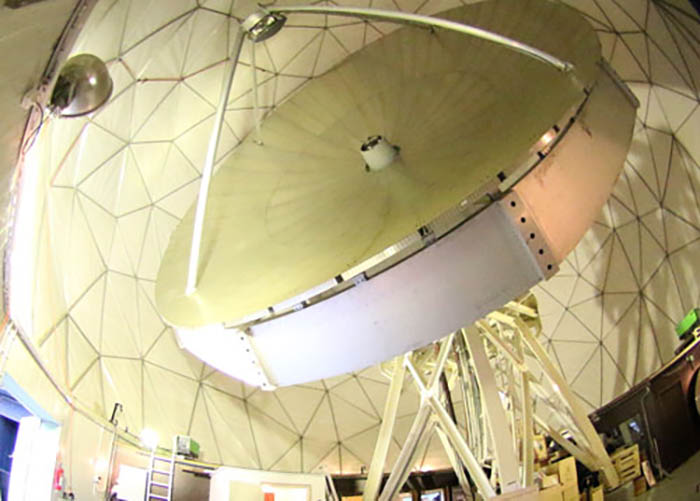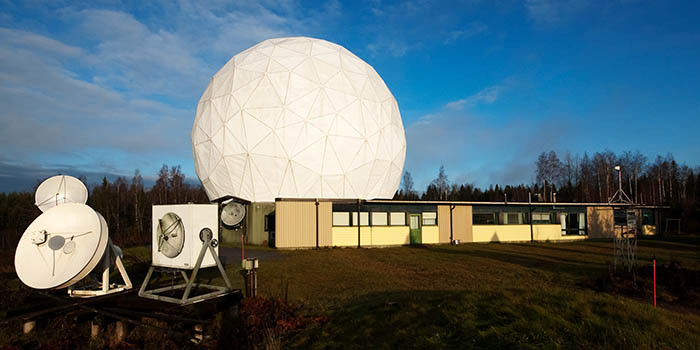Research
The research activities at Metsähovi are concentrated on observations done at millimetre waves and microwaves (2-150 GHz). The main areas of scientific interest are: solar millimeter and microwave radiation, variable quasars and active galaxies, and very long baseline interferometry (VLBI). The research in technology includes development of data acquisition, data processing, receivers and receiving methods. The main focus is in fundamental research, and we aim at being in the international forefront of our research fields.
Students can carry out their Master's and PhD thesis work in Metsähovi, instructed by the staff scientists. Students are integrated into our research team in the very early stages of their studies, starting as summer students, research assistants and observers and later working on a dedicated subfield under the close supervision of senior scientists from Metsähovi and collaborative institutes.
The Metsähovi radio telescope is one of the very few radio telescopes in Europe capable of doing millimetre-wavelength radio astronomy, thanks to the high surface accuracy (0.1 mm rms). The telescope is operational 24h/day every day of the year, save for inevitable interruptions due to weather, instrument changes, maintenance etc.

Most of the telescope time is dedicated to a world-famous project of total flux density monitoring of Active Galactic Nuclei (AGN) at high radio frequencies. This is a project that has produced a unique data base of more than 35 years of AGN variability data at the otherwise very rarely observed bands of high radio frequencies and also has produced – and is continuously producing – a very large number of scientific publications in refereed journals as well as Doctoral and Master’s theses. While most of the telescope time is dedicated to this ongoing long-term monitoring of AGN, it is also being used for astronomical and geodetic Very Long Baseline Interferometry (VLBI) as well as other fields of radio astronomy, such as Solar observations. The Northern location of Metsähovi gives us the opportunity to collect almost uniterrupted data sets of Solar data in the summer months, but daily images of the radio Sun are produced throughout the year. Due to our flexible telescope time scheduling, the telescope is also used for unpredictable events, such as Target-of-Opportunity observations of X-ray binaries.
In VLBI observations the telescope is a node of a large network of radio telescopes simultaneously observing the same source and thus forming a gigantic virtual telescope – the angular resolution of this sophisticated but technologically very demanding observing technique exceeds that of any other available instruments. Three VLBI user communities make use of the Metsähovi telescope: the European VLBI Network (EVN) for 22 GHz and 43 GHz astronomical VLBI observations, the Global Millimetre-VLBI Array (GMVA) for 86 GHz astronomical observations, and the International VLBI Service for Geodesy and Astrometry (IVS) for 2 + 8 GHz geodetic VLBI. The latter project is carried out in Metsähovi as part of a research contract with the Finnish Geodetic Institute (FGI).
The astronomical VLBI observations in Metsähovi are done as part of our commitment to participate in activities that have potential for breakthrough science. Additionally, VLBI experiments involving high-speed data transfer tests or involving exceptionally high observing frequencies producing superb angular resolution, or projects observing specific Target-of-Opportunity projects (tracking the signal of a planetary probe, detecting water in the vicinity of Saturn, etc.) have been conducted. Metsähovi is one of the few observatories in the world capable of this kind of flexibility: the telescope schedule can easily be changed on demand when new scientific or technical breakthroughs are anticipated, or at least an opportunity to explore beyond the conventional “proposal-writing science” is called for.
Practically all of our research activities are done as part of international collaborative efforts – by their very nature, multifrequency studies of AGNs as well as VLBI observations and VLBI development, call for active international collaboration. We participate in the RadioNet3 project.



